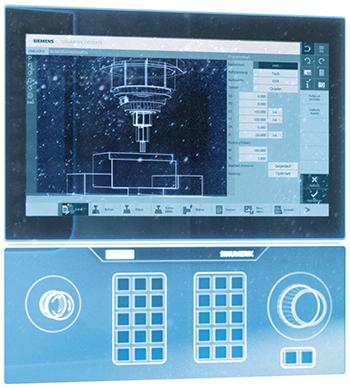
CNC Software, Inc., producers of Mastercam CAD/CAM software, announced new 5-axis milling post processors that will unleash the highest productivity on SINUMERIK-controlled machine tools. These new post processors were developed utilizing the technical expertise of Siemens CNC engineers.
These post processors include support for SINUMERIK 840D and SINUMERIK ONE CNCs from Siemens. Some features include:
- Table/Table (AC/BC/Nutating) Support.
- Rotary and Vector Programming.
- Advanced Surface / Top Surface (COMPCAD / COMPSURF).
- CYCLE 832 Support for High Speed Settings (OTOL).
- CYCLE 800 Tilted Workplane (3+2).
- TRAORI – Tool Center Point Control (ORIWKS, ORIMKS, ORIAXIS, ORIVECT, and ORISON/ORISOF).
- SUPA (suppress all [offsets]).
- Work offset support matching control capabilities (G54-G57/G507-G599).
- Optimized Drilling Cycles (CYCLE 82, 83, 84, 85, 86, 840).
- Numerical tool call with offset D#.
- TOFFR functionality to support cutter comp wear strategy.
- A Siemens application guide.
“Providing this new 5-axis post for Mastercam continues to extend the benefit of our ongoing relationship with Siemens from the creation of our 3-axis, 4-axis, and now the 5-axis post processors that will bring the highest productivity gains to machine tools for customers. Our post engineers and Siemens engineers have done a fantastic job making sure we provide the most common options for our mutual customers,” says Mastercam Post Department Manager Pedro Sanchez, Jr.
It is cooperation like this that provides Mastercam users the opportunity to truly complement their CAM investment and give their shops the best chance at a more efficient manufacturing solution, from design to part.
Chris Pollack, Virtual Technical Application Center Manager, Siemens Industry, Inc. comments, “When driving advanced technology, such as 5-axis machine tools, the quality and capability of the post processor is arguably one of the most important pieces in the manufacturing process chain. After working with the exceptional Post Engineers at CNC Software, I can truly say that this latest post is a thing of beauty. It allows both the SINUMERIK CNC as well as Mastercam to operate at its fullest potential.”
According to Dr. Jochen Bretschneider, Product Manager SINUMERIK Technologies, Siemens AG Erlangen, “It is well known that the post processor determines the efficiency of 5-axis simultaneous machining that end users can achieve on their machines. Only if the correct command set of the CNC control is addressed by the post processor can the full performance in terms of machining times and surface quality be achieved. With the new Mastercam 5-axis mill post processor it is guaranteed that not only the proven SINUMERIK 840D sl can be optimally operated, but also the future-oriented, powerful SINUMERIK ONE. End users therefore can cover existing machinery with SINUMERIK 840D sl as well as brand new machines equipped with SINUMERIK ONE.”
Contact Details
Related Glossary Terms
- computer numerical control ( CNC)
computer numerical control ( CNC)
Microprocessor-based controller dedicated to a machine tool that permits the creation or modification of parts. Programmed numerical control activates the machine’s servos and spindle drives and controls the various machining operations. See DNC, direct numerical control; NC, numerical control.
- computer-aided manufacturing ( CAM)
computer-aided manufacturing ( CAM)
Use of computers to control machining and manufacturing processes.
- gang cutting ( milling)
gang cutting ( milling)
Machining with several cutters mounted on a single arbor, generally for simultaneous cutting.
- milling
milling
Machining operation in which metal or other material is removed by applying power to a rotating cutter. In vertical milling, the cutting tool is mounted vertically on the spindle. In horizontal milling, the cutting tool is mounted horizontally, either directly on the spindle or on an arbor. Horizontal milling is further broken down into conventional milling, where the cutter rotates opposite the direction of feed, or “up” into the workpiece; and climb milling, where the cutter rotates in the direction of feed, or “down” into the workpiece. Milling operations include plane or surface milling, endmilling, facemilling, angle milling, form milling and profiling.
- milling machine ( mill)
milling machine ( mill)
Runs endmills and arbor-mounted milling cutters. Features include a head with a spindle that drives the cutters; a column, knee and table that provide motion in the three Cartesian axes; and a base that supports the components and houses the cutting-fluid pump and reservoir. The work is mounted on the table and fed into the rotating cutter or endmill to accomplish the milling steps; vertical milling machines also feed endmills into the work by means of a spindle-mounted quill. Models range from small manual machines to big bed-type and duplex mills. All take one of three basic forms: vertical, horizontal or convertible horizontal/vertical. Vertical machines may be knee-type (the table is mounted on a knee that can be elevated) or bed-type (the table is securely supported and only moves horizontally). In general, horizontal machines are bigger and more powerful, while vertical machines are lighter but more versatile and easier to set up and operate.
